Services on Demand
Journal
Article
Indicators
-
 Cited by SciELO
Cited by SciELO -
 Access statistics
Access statistics
Related links
-
 Similars in
SciELO
Similars in
SciELO  uBio
uBio
Share
Revista de Biología Tropical
On-line version ISSN 0034-7744Print version ISSN 0034-7744
Rev. biol. trop vol.46 n.3 San José Sep. 1998
Abstract
Oplonaeschna magna sp. nov. (Odonata:Aeshnidae) (holotype and allotype
deposited at CNIN UNAM-MEX., México, D. F.) is described and illustrated from specimens collected in the states of Estado de México, Guerrero, Hidalgo, and Morelos, México. This is the second species of the genus Oplonaeschna. Adults of O. magna can be separated from those of O. armata (Hagen, 1861) by their larger size and broader thoracic stripes. The larva of the new species is also easily distinguished from that of O. armata by its larger size and longer prementum, and by structural differences of palpal lobes and epiproct. The larva of O. armata is briefly redescribed, illustrated and compared to that of O. magna. Notes on the biology of the new species are provided
Key words
Odonata, Aeshnidae, Oplonaeschna, new species, adult, larva, taxonomy, morphology, Mexico
The genus Oplonaeschna was erected by Selys in 1883 to include a unique species, O. armata, originally described by Hagen (1861) under the genus Aeshna. The genus has since remained monotypic. The geographic distribution of Oplonaeschna extends from southwestern USA (Arizona and New Mexico) to Mexico and Guatemala.
The larva of O. armata was briefly described and keyed by Needham & Westfall (1955) based on young specimens, but their figure is not easily comparable to full grown larvae of other Aeshnidae figured in the same work.
Here we describe a second species, Oplonaeschna magna sp. nov., and its larva from material collected in the states of Hidalgo, Guerrero, Estado de México, and Morelos, México. We also provide a complementary redescription and diagnostic detailed figures for the larva of O. armata, in order to compare it with the larva of the new species.
Materials and Methods
Adults were collected at Tepoztlán, Morelos, and five other localities between 1981 and 1994; photographs of some living specimens were taken in order to accurately describe the coloration of this species. Most specimens were acetoned for 24 hours to preserve coloration. One larva was observed while transforming into an adult in the field. Both, the exuviae and teneral adult were captured and preserved to assure positive correlation between larval and adult stages. A single last-instar larva was captured with an aquatic net; this and several exuviae were preserved in 80% ethanol. Descriptions and illustrations were made using stereoscopic microscope outfitted with a camera lucida. Larval and some imaginal measurements were made with the aid of a micrometer. Nomenclature for abdominal maculation of adults follows Walker (1912) as modified by Calvert (1956). Terminology for the labium and setae follows Corbet (1953). Acronyms for specimen repositories as follows:
CNIN (UNAM-MEX)- Colección Nacional de Insectos, UNAM, México (ex IBUNAM).
IEXA- Colección Entomológica del Instituto de Ecología, A. C., Xalapa, Veracruz.
BMNH - British Museum (Natural History)(London). NMNH - National Museum of Natural History (Washington). Others as indicated below.
Material examined - HolotypeMEXICO: MORELOS state, Tepoztlán,4/Nov./1990, (E. González) - Allotype
:same data as holotype. -Paratypes(55
4
). - MEXICO: ESTADO DE MEXICO, Malinalco (3
1
), 2/Nov./1992 (E. González & Luis E. González); GUERRERO, Ixcateopan (1
),26/July/1981, (M. Gutiérrez); Los Retrocesos, Mpío. de Atoyac (1
),31/Aug./1983, (A. Luis); HIDALGO, El Chico (2
), 1/Nov./1982, (J. Villa); MORELOS, Metepec (1
), 3/Nov./1990, (E. González); Tepoztlán (9
, 2 ), 10/Oct./1985, (E. González & V. García); same locality (2
), 8/Nov./1985, (V. García); same locality (2
), 9/Nov./1986, (V. García); same locality (4 xx), 4/Nov./1990, (E. González); same locality (21
, 2
), 11/Dec./1993, (R. Novelo); same locality (9
), 19/Nov./1994, (R. Novelo).
Total: 56 x and 5 : Holotype, allotype and 27 paratypes deposited in CNIN (UNAM-MEX), 32 paratypes deposited in IEXA; other paratypes in British Museum (Natural History)(London)(BMNH), National Museum of Natural History (Washington)(NMNH) and collections of Rosser W. Garrison (Azusa, CAL.), Dennis R. Paulson (Tacoma, WAS.) and Sidney W. Dunkle (Plano, TEXAS).
Etymology.- From the Latin magnus, meaning "large", referring to the large size of this species
Description. Holotype male. Head- Labium and mandibles reddish brown; labrum yellow green; anteclypeus dull green, postclypeus and frons lemon green with an ill-defined brownish stripe along frontoclypeal suture; genae brown; face hairy, especially at sides; postfrons with a black spot, its wide stalk and a narrow upper piece barely resembling a "T"; vertex black, covered with long erect sparse hairs, and with a small green spot on its anterior margin; occiput green, a small triangular black spot at posteromedial margin. Antennae black, rear of head brown. Eyes deep blue in life.
Thorax- Prothorax dark brown; posterior margin of posterior lobe fringed with long black hairs. Synthorax dark brown with antehumeral, mesepimeral, and metepisternal stripes yellow with washes of light green; antehumerals with a wide stalk and incomplete upper piece forming an inverted "L"; mesepimeral stripes wide, with anterior margin sinuous; a small yellow spot above metastigma. Metepimeral stripes very wide occupying most of metepimeron. Coxae, trochanters, and femora reddish brown, prothoracic femora with internal surface blue, distal part of all femora and tibiae black, tarsi reddish. Venation black, pterostigma dark brown, nodal formula: 16:21/21:15 (fore wing:FW), 16:14/12:16 (hind wing:HW); triangles 5 celled (FW), 4 in (HW); supratriangles 5(FW), 4(HW); anal triangles 3 celled; anal loop 9 (left HW) and 10 (right HW).
Abdomen- Dark brown with pale yellowish-green or bluish-green spots as follows:
D and L present in segment 1 (the former apparently blue in life); MD on 2-7; PD present on 2-5 (blue in 2-3), on 2 connected ventrally with PL which is also fused anteriorly with AML; AL present on 3-7; ML present on 3-8; PL absent in all segments except in 2; 9 dark; 10 with two large dorsal green spots.
Structural characters - Auricles with 11 (L) and 9 (R) denticles; anterior laminae with spine extending posteriorly almost reaching level of hind margin of the hamular process (Fig. 1). Mesal margins of anterior laminar spine convex in anterior half, converging medially at their posteriorly end.
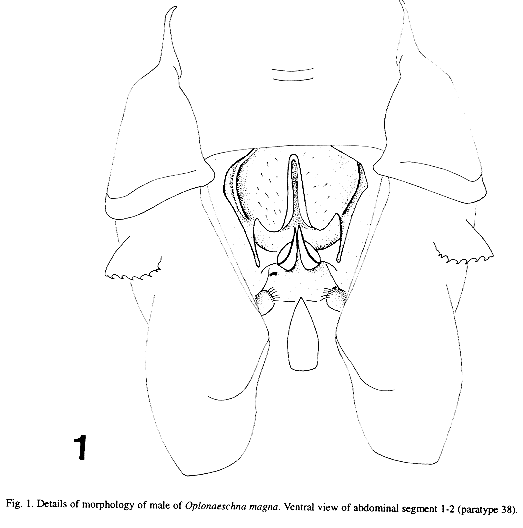
Dorsum of segment 10 with a dorsoposteriorly directed robust spine occupying 0.9 the length of segment (Fig. 2a). Cerci longer than segments 9+10; in dorsal view slightly fusiform (Fig. 2b), with interior margin apically sinuated, ending in an acute distal spine and with an elevated carina at 0.60 its length; the inner margin of carina with 4 denticles, the posterior, the smaller; epiproct roughly triangular in ventral view, extending 0.50 the length of cercus, in lateral view with two small teeth directed anterodorsally (Fig. 2a).
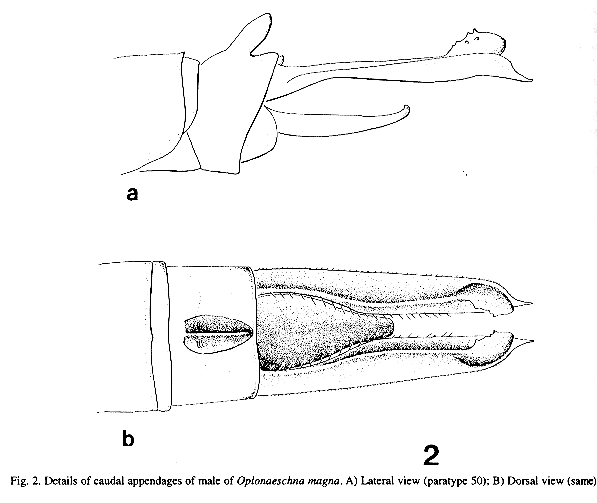
Measurements (mm). -Total length including appendages 77.6, abdomen 53.0, cerci 6.1, hindwing 51.6, pterostigma 2.4 (FW), 2.5 (HW).
Allotype female - With similar coloration than male but with the following differences: Venation: Nodal formula 15:22/24:14 (FW), 14:13/13:12 (HW); triangles 5 celled (FW), 4 in (HW); supratriangles 5(FW), 3 (left HW) and 4 (right HW); anal loop with 12 cells.
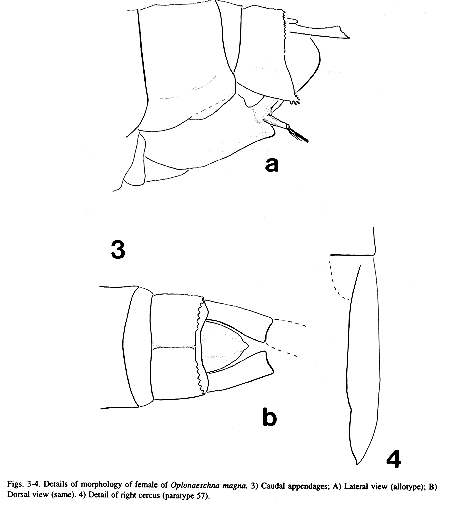
Abdomen - Segments 1-4 with similar maculation to those of male, although PD more reduced than in male and with no traces of bluish coloration. Segments 5-7 with AL present but divided in two spots by a brown stripe, ML larger than in male, PD small and only visible in 5-6; seg 8 with traces of AL, but ML fused with PL forming an elongated spot; an additional spot occupying a point half the way between PD and PL, 9 and 10 brown unspotted. Caudal appendages as in Fig 3. Cerci longer than segment 9, lanceolated (Fig. 4)(broken in allotype, figure drawing from paratype #57).
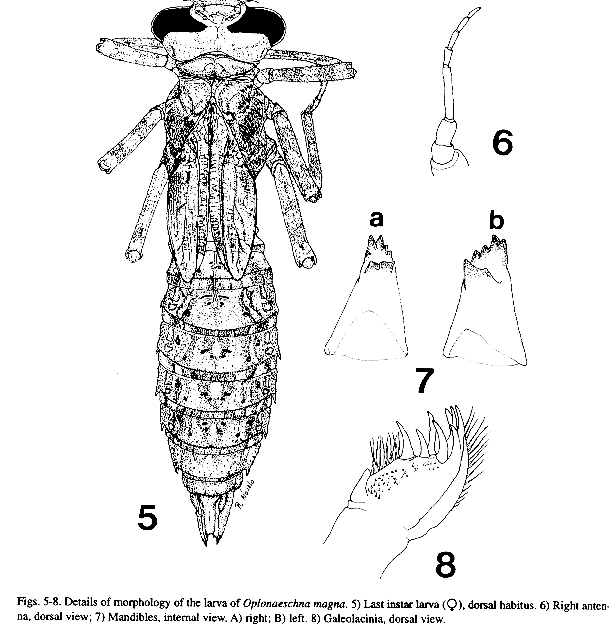
Measurements (mm). Total length not including abdominal appendages (Appendages broken) 71.2, abdomen 52.7, cerci (in paratype #57) 4.5, hind wing 53.5, pterostigma FW 2.4, in HW 2.7.
Remarks - The following variation was observed among paratypic series. Venation (males): antenodals in forewing (FW) 15(36%), 14(23%), 13(16%), 16(13%), 17(9%), 18(2%), 12(1%); in hindwing (HW) 15(30%), 16(27%), 14(19%), 17(10%), 13(9%), 11(2%), 12(1%), 18(1%),19(1%); postnodals (FW) 20(31%), 19(24%), 21(17%), 18(14%), 22(5%), 17(3%), 16(2%), 23(2%), 13(1%), 24(1%); (HW) 12(34%), 13(33%), 14(16%), 11(9%), 15(7%), 17(1%); triangles (FW) 4(56%), 5(42%), 3(1%), 4(1%); (HW) 4(88%), 5(7%), 3(5%); supratriangles (FW) 4(55%), 5(32%), 3(8%), 6(4%), 2(1%); (HW) 3(70%), 4(29%), 2(1%); anal triangles 3(77%), 4(19%), 5(3%), 2(1%); anal loop 10(37%), 11(24%), 12(20%), 9(9%), 13(6%), 8(3%), 7(1%). Venation (females): antenodals (FW) 15(40%), 14(30%), 13(10%), 16(10%), 17(10%); (HW) 15(40%), 17(20%), 13(10%), 14(10%), 16(10%), 18(10%); postnodals (FW) 19(30%), 18(20%), 20(20%), 16(10%), 21(10%), 22(10)%); (HW) 12(45%), 13(33%), 14(11%), 15(11%); number of cells in triangles (FW): 4(100%); (HW) 4(100%); in supratriangles (FW) 4(56%), 5(44%); (HW) 3(71%), 4(29%); in anal loop 11(38%), 10(25%), 12(25%), 9(12%).
In a single specimen collected in Metepec, Morelos which has larger pale spots, MD is connected with ML on 2-7; AL is connected with ML on 3-8 and ML is fused with MD on 3-7.
Measurements (mm). Males: total length average (range in parentheses) 76.4 (69.7-80.2), abdomen 52.4 (47.6-53.6), cerci 6.1 (5.5-6.6), hindwing 50.2 (48.9-54.2), pterostigmata (FW) 2.02 (1.9-2.8), in hindwing 2.3 (1.9-3.0). Females: total length 69.2 (68.8-69.9), abdomen 51.3 (50.5-51.6), hind wing 55.9 (53.2-58.6).
Material examined: 13 exuviae (8, 5
), 1 larva (
) last instar. MEXICO: MORELOS state; Tepoztlán, 11/Oct./1985, (R. Novelo, E.González). Deposited at IEXA.
Description: Body yellowish-brown, with roughly granulated and hairless skin. Legs ringed with pale and dark bands. Abdomen lanceolate (Fig. 5)
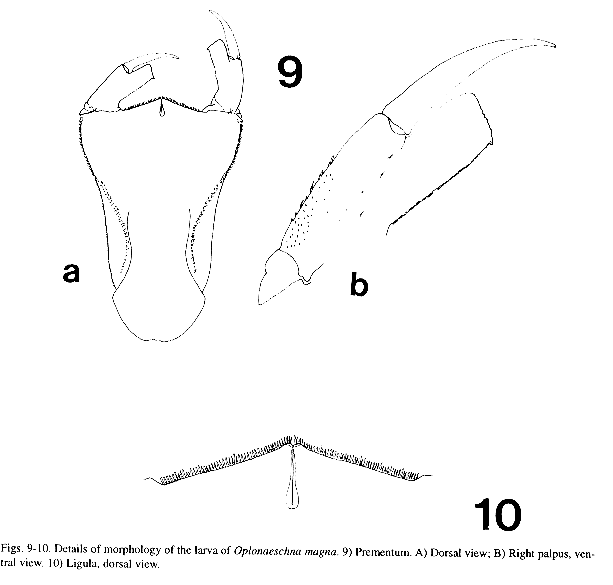
Head: wider than long with abundant, minute, spiniform setae except on anteclypeus, which is glabrous; posterior margin of occiput concave, cephalic lobes rounded. Compound eyes large, prominent. Labrum trapezoidal, profusely covered with spiniform setae excepting for a small, circular, median area. Antennae short, 7-jointed, third antennomere the longest; relative length of antennomeres: 0.5, 0.6, 1.0, 0.4, 0.5, 0.4, 0.3; scape and pedicel darker than flagellum (Fig. 6). Mandibles biramous (Fig. 7), external branch with five and four cuspids on right and left mandibles respectively, internal branch in both mandibles with two robust teeth fused medially by a transversal ridge. Maxillae: galeolaciniae with 7 long, stout, curved teeth preceded basally by robust long setae (Fig. 8). Labium: Prementum-postmentum articulation reaching the posterior margin of mesocoxae. Prementum longer than wide, narrowing basally; lateral margins convex at apical 0.30, remainder more or less straight, with a double row of spiniform setae (Fig. 9a). Palpi with apical lobe squarely truncated, rounded on superior angle but with a small, blunt tooth on inferior one (Fig. 9b); internal margin finely serrate, external one with spiniform setae. Movable hook short, shorter than palpus. Ligula moderately prominent, its distal margin covered with abundant pilliform setae, median cleft deep, closed (Fig. 10).
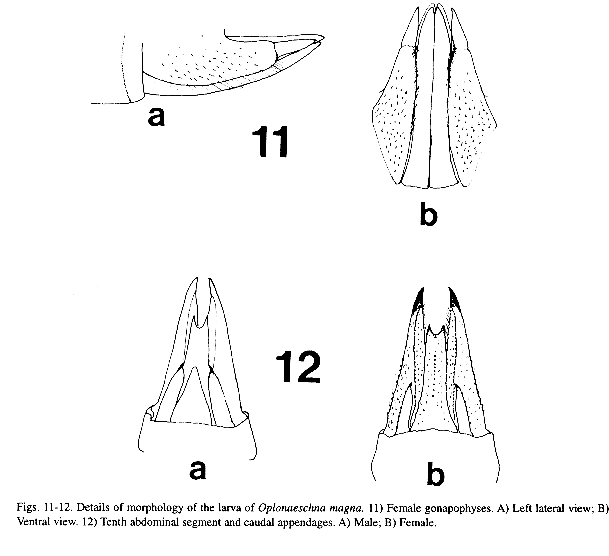
Thorax profusely covered with minute spiniform setae. Proepisterna, proepimera, and lateral margins of pronotum projected laterally into a blunt-tipped, conic protuberance; posterior margin of pronotum widely rounded. Synthorax reddish-brown with a yellow spot on dorsal end of each lateral suture in last instar larva. Wing pads with parallel sides, reaching the middle and posterior margin of abdominal segment 4, respectively. Legs ringed with alternating pale and dark bands and with abundant spiniform setae; claws with an epodium.
Abdomen lanceolate, widened just behind the middle (Fig. 5), lacking dorsal protuberances; lateral spines on 5-9, those on 7-8 the longest. Abdominal surface and lateral margins with abundant minute spiniform setae; posterior margins of tergites 2-10 with a row of obtuse, red, spiniform setae which increase in size gradually from front to rearward. Color pattern as in Fig. 5. Male gonapophyses vestigial; those of female well developed, the dorsal ones the largest (Fig. 11a); lateral gonapophyses convergent at apex, with spiniform setae on lateral surface and ventral border, the central ones smooth (Fig. 11b). Caudal appendages yellowish-brown, except for reddish-brown on the tips. Male (Fig. 12a): Cercus digitiform, parallel-sided but abruptly narrowed and pointed at apical 0.20, with spiniform setae on lateral margins. Epiproct parallel sided, ending apically in two sharp points widely separated by a median U-shaped cleft; with a basidorsal, conic, round-tipped tubercle almost as long as cercus, occupying basal 0.50 the length of epiproct; lateral margins roughly serrulate ventrally. Paraprocts pyramidal, sharp-edged; the supero- and ventrointernal edges roughly serrulate; their tips moderately incurved, ending in a strong, acutely-pointed spine; a tuft of long, stout setae present on ventrobasal part of spine. Relative length of male caudal appendages: cerci 0.46, epiproct 0.74, paraprocts 1.0. Female (Fig. 12b): Cercus digitiform, gradually narrowed at apex, their tips are acutely-pointed and convergent; with spiniform setae on lateral margins. Epiproct as in male but lacking basidorsal tubercle. Paraprocts as in male. Proportions: cerci 0.36, epiproct 0.73, paraprocts 1.0.
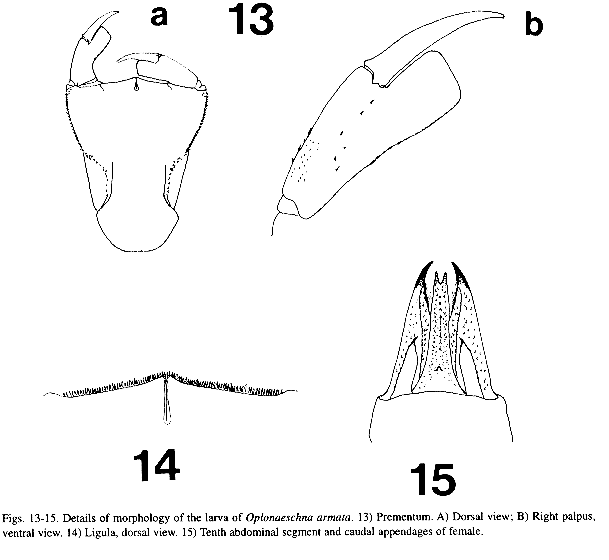 Measurements (in
Measurements (inmm): Last instar larva (): Total length (including appendages) 43; abdomen 28; maximum width of head 9.5; hind femur 8.0. Lateral spines on abdomen: on 5, 0.2; on 6, 0.7; on 7, 0.8; on 8, 0.8; on 9, 0.6. Cerci 1.6; epiproct 3.5; paraprocts 4.9. Exuviae (
): Total length 45-49; abdomen 29.5-33; maximum width of head 9.5-10.3; hind femur 7.8-8.2; lateral spines on abdominal segment 5: 0.2-0.4; on 6 0.7-0.9; on 7 0.9-1.1; on 8 0.9-1.1; on 9 0.7-0.9. Cerci 1.9-2.5; epiproct 3.5-4.1; paraprocts 4.7-5.3. (
): Total length 46-51; abdomen 31-33; max. width of head 10-10.5; hind femora 7.8-8.7; lateral spines on abdominal segment 5: 0.2-0.4; on 6 0.8-0.9; on 7 1.0-1.1; on 8 1.0-1.1; on 9 0.6-0.9. Cerci 1.8-2.1; epiproct 3.6-4.3; paraprocts 5.0-6.0.
Material examined: 3 exuviae (), 1 last instar larva (
). MEXICO: MORELOS; Tetela del Volcán, 11/Aug./1984, (R. Novelo) (3
). MEXICO, HIDALGO; Tuzanapa, 29/July/1986, (R. Novelo) (1
). Deposited at Colección de Insectos Acuáticos, Instituto de Ecología (IEXA), Xalapa, Veracruz, México.
Redescription: As in Oplonaeschna magna except for following differences: Labium: Prementum-postmentum articulation reaching anterior margin of mesocoxae, little longer than wide (Fig. 13a). Superior and inferior angles of apical lobe of palpus rounded (Fig. 13b). Ligula and median cleft as in Fig 14. Caudal appendages of female (Fig. 15): Epiproct with or without a dorsal spine at basal 0.3; apical cleft V-shaped. Paraprocts more incurved than in O. magna. Relative length of caudal appendages: 0.40-0.49; 0.80-0.95; 1.0 (cerci, epiproct and paraprocts respectively).
Measurements (in mm): Last instar larva (): Total length (including appendages) 39; abdomen 25.5; maximum width of head 9.0; hind femur 7.2. Lateral spines on abdomen: on 5, 0.3; on 6, 0.7; on 7, 0.9; on 8, 0.9; on 9, 0.7. Cerci 1.9; epiproct 3.8; paraprocts 4.0. Exuviae (
): Total length 37.5-39; abdomen 24-26; maximum width of head 8.0-8.5; hind femur 6.3-6.4. Lateral spines on abdomen: on 5, 0.4-0.5; on 6, 0.6-0.9; on 7, 0.7-1.0; on 8, 0.7-1.0; on 9, 0.6-0.9. Cerci 1.6-1.9; epiproct 3.2-3.3; paraprocts 3.9-4.0.
Ecology - Larvae of O. armata were recorded by Needham & Westfall (1955) living in residual pools of rocky canyon streams that are subject to flash floods. Johnson (1968) also found larvae in similar habitats in New Mexico and Arizona. Headwaters of major creeks and small, permanent, spring-fed rocky streams of arid southwestern mountains appear to be the only known habitats for this species in the USA (Johnson 1968). In Mexico, we found O. armata inhabiting mountain streams in temperate zones (more than 2000 m in Morelos and Durango states), but it was also found in streams of subtropical areas at lower elevations (900 m in Morelos state). Oplonaeschna magna also inhabits rocky canyon streams and at least one locality (El Chico, Hidalgo State) is located above 2000 m of altitude.
At Tepoztlán, Morelos, most adults were collected in November. Males were captured while patrolling back and forth in a small stream. They showed pursuit flights toward each other, however no territorial defence was noted. We saw one succesful copulation attempt. A male captured a female in flight above the stream and the ensuing wheel position was formed. Copulation lasted for more than one hour until the pair moved away from the area of observation.
Males and females were also collected while feeding in groups above the middle of a road. The "hawk-like" behavior was similar to other aeshnids (e.g., Coryphaeschna, Remartinia, and Aeshna) we have observed.
At Tepoztlán, all adults collected in November were young (judging by the brilliance of their wings), suggesting the possibility that adults emerge synchronously in this area. Other common odonates found were Archilestes grandis, Argia plana, Libellula saturata, Paltothemis lineatipes and Sympetrum illotum. At two localities (Metepec and El Chico) we collected both O. magna and O. armata flying together.
The single last instar larva collected in Tepoztlán was found in a residual pool among rocks and decomposed twigs and leaves; another larva was observed while transforming into an adult, climbing on a fallen tree trunk at 13:07 hours. Exuviae were clinging on the vertical rocky walls of the canyon, attached to moss at 0.80 to 1.25 m above water, and on tree trunks and shrubs even at 3 m height. This emergence behavior contrasts strongly to that recorded by Johnson (1968) for O. armata, in which the emergence rarely took place more than 60 cm above water, and never on tree trunks or fallen limbs.
Discussion
In his discussion on O. armata, Calvert (1905) called attention to the apparent geographic variation within individuals collected between Arizona (USA) and Cuernavaca (Mexico). He noted that one individual, determined by R. McLachlan, had the stripes of the thorax unusually wide. Although we did not study this specimen (which is apparently deposited in the NMNH Washington), we believe, judging by Calvert's description, that it probably represents O. magna.
Adults of O. magna are easily separated from those of O. armata by their greater size and much broader pale thoracic stripes ( see Fig. 16). The size and color differences between the two species are manifested by the following character comparison (those of O. armata in parentheses): mesepimeral stripes: 2.17 mm on average (0.94 mm), metepimeral stripes 2.69 mm (0.83 mm), spines of anterior laminae 1.96 mm (0.80 mm).
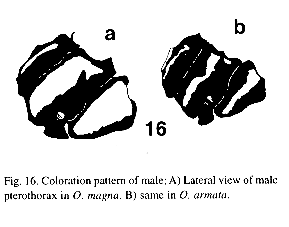
The larvae of O. magna is distinguishable from O. armata by their overall greater size and by the following structural differences: prementum-postmentum articulation reaching hind margin of mesocoxae, prementum enlarged basally, inferior angle of apical lobe of palpus with a small tooth, paraprocts less incurved, epiproct notably shorter with respect to paraprocts and with apical cleft U-shaped, and length of spine on abdominal segment 5 is longer than in O. magna.
Acknowledgements
We thank D. R. Paulson and R. W. Garrison for their comments and critical review of the manuscript. We also thank Guillermina Ortega León for producing the drawings of adult structures.
Resumen
Se describe el adulto y la náyade de Oplonaeschna magna (Odonata: Aeshnidae), una nueva especie recolectada en los estados de Estado de México, Guerrero, Hidalgo, y Morelos, México. Los adultos de O. magna pueden ser reconocidos fácilmente de los de O. armata por su mayor tamaño y desarrollo de las bandas pálidas del tórax. Las náyades de la nueva especie se distinguen también con facilidad de las de O. armata por el mayor tamaño y longitud del prementón y por otras diferencias en la morfología de los lóbulos palpales y del epiprocto. Se proporcionan notas sobre la biología de la nueva especie.
References
Corbet, P. S. 1953. A terminology for the labium of larval Odonata. Entomologist 86:191-196. [ Links ]
Calvert, P. P. 1905. Biologia Centrali Americana. Porter & Dulau, London. [ Links ]
Calvert, P. P. 1956. The neotropical species of the "subgenus Aeshna" sensu Selysii 1883 (Odonata). Mem. Amer. ent. Soc. 15: V+ 251 pp., 47 pls excl. [ Links ]
Hagen, H. 1861. Synopsis of the Neuroptera of North America. Smithsonian Misc. Coll., Washington. 347 p. [ Links ]
Johnson, C. 1968. Seasonal ecology of the dragonfly Oplonaeschna armata Hagen (Odonata: Aeshnidae). Amer. Midl. Nat. 80:449-457. [ Links ]
Needham, J. G. & M. J. Westfall Jr. 1955. A Manual of the dragonflies of North America (Anisoptera). University of California, Berkeley. 615 p. [ Links ]
Selys, E. 1883. Synopsis des Aeschnines. 1re partie. Classification. Bull. Acad. r. Belg. 3:712-748. [ Links ]
Walker, E. M. 1912. The North American dragonflies of the genus Aeshna. Univ. Toronto Stud. (Biol.)11:1-213, pls 1-28 excl. [ Links ]
1 Instituto de Biología, Depto. de Zoología, Universidad Nacional Autónoma de Mexico, Apdo. Postal 70-153, C. P. 04510, Mexico, D. F. E-mail esoriano@mail.ibiologia.unam.mxmailto:esoriano@mail.ibiologia.unam.mx
2 Instituto de Ecología, A. C., Depto. Biosistemática de Insectos, Apdo Postal 63, 91000, Xalapa, Veracruz, Mexico. E-mail novelor@sun.ieco.conacyt.mx.














